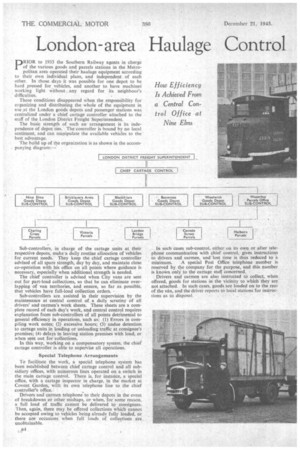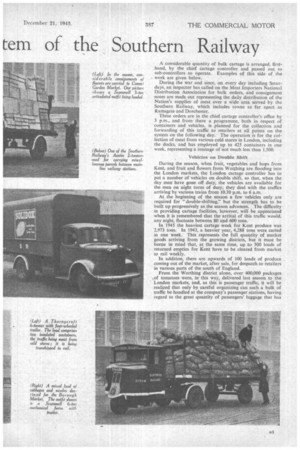London-area Haulage Control tern of the Southern Railway
Page 30

Page 31

Page 32

If you've noticed an error in this article please click here to report it so we can fix it.
pRJOR to 1933 the Southern Railway agents in charge ge according to the various goods and parcels stations in the Metro politan area operated their haulage equipment accding independent o to their own individual plans, and indf each ther. To those days it was possible for one depot to be have machines hard pressed for vehicles, and another to h working light Without _any regard for its neighbour's difficulties. Those conditions disappeared when the responsibility for organizing and distributing the whole of the equipment in use at the London goods depots and passenger stations was centralized under a chief cartage controller attached to the staff of the London District Freight Superintendent. The basic strength of such an • arrangement is its independence of depot ties. The controller is bound by no local sentiment, and can manipulate the available vehicles to the best advantage, The build up of the organization is as shown in the accompanying diagram:— Sub-controllers, in charge of the cartage units at their respective depots, make .a daily routine allocation of vehicles for current needs. They keep the chief cartage controller advised of all spare strength, day by day, and maintain close co-operation with his office on all points where guidance is necessary, especially when additional strength is needed. The chief controller is advised when City vans are sent out for part-load collections, so that he can eliminate overlapping of van territories, and ensure, so far as possible, that vehicles have full-load collection orders. • Sub-controllers are assisted in. their supervision by the maintenance at central control of. a daily scrutiny of all drivers' and earmen's work sheets. These sheets are a complete record of each day's work, and central control requires explanation from sub-controllers of all points detrimental to general efficiency in operations, such as: (1) Errors in compiling work notes; (2) excessive hours; (3) undue detention to cartage units in loading or unloading traffic at consignee's premises; (4) delays in leaving station premises with load or when sent out for collections. In this way, working on a compensatory system, the chief cartage controller is able to supervise all operations.
Special Telephone Arrangements To facilitate the work, a special telephone system has been established between chief cartage control and and all subsidiary offices, with numerous lines operated on a switch in the main cartage control. There is, for instance, a special office, with a cartage inspector in charge, in the market at Covent Garden, with its own telephone line to the chief controller's office. Drivers and carmen telephone to their depots in the event of breakdowns or other mishaps, or when, for some reason. a full load of traffic cannot be delivered to consignees. Then, again, there may be offered collections which cannot be accepted owing to vehicles being already fully loaded, or there are occasions when full loads of collections are unobtainable. In such cases sub-control, either on its own or after telephone communication with chief control, gives instructions to drivers and carmen, and lost time is thus reduced to a minimum. A special Post Office telephone number is reserved by the company for the purpose, and this number is known only to the cartage staff concerned. Drivers and carmen are also instructed to collect, when offered, goods for stations in the vicinity to which they are not attached. In such cases, goods are loaded on to the real of the van, and the driver reports to local stations for instimelions as to disposal.
A considerable quantity of bulk cartage is arranged, firsthand, by the chief cartage controller and passed out to sub-controllers to operate. Examples of this side of the work are given below.
During the war and since, on every day including Saturdays, an inspector has called on the Meat Importers National Distribution Association for bulk orders, and consignment notes are made out representing the daily distribution of the Nation's supplies of meat over a wide area served by the Southern Railway, which includes towns as far apart as Ramsgate and Dorchester.
These orders are in the chief cartage controller's office by 3 p.m., and from there a programme, both in respect of containers and vehicles, is planned for the collection and forwarding of this traffic to retailers at all points on the system on the following day. The operation is for the collection of meat from various cold stores in London, including the docks, and has employed up to 425 containers in one week, representing a tonnage of not much less than 1,500.
Vehicles on Double Shift
During the season, when fruit, vegetables and hops from Kent, and fruit and flowers from Worthing are flooding into the London markets, the London cartage controller has to put a number of vehicles on double shift, so that, when the day menhave gone off duty, the vehicles are available for the men on night turns of duty; they deal with the traffics arriving by various trains from 10.30 p.m. to 6 a.m.
At the beginning of the season a few vehicles only are required for "double-shifting," but the strength has to be built up progressively as the season advances. The difficulty • in providing cartage facilities, however, will be appreciated when it is remembered that the arrival of this traffic would, any night, fluctuate between 80 and 600 tons.
In 1945 the heaviest cartage week for Kent produce was 2,973 tons. In 1943, a heavier year, 4,288 tons were carted in one week. This represents the full quantity of market goods arriving from the growing districts, but it must be borne in mind that, at the same time, up to 300 loads of returned empties for Kent have to be cleared from market to rail weekly. In addition, there are upwards of 100 loads of produce coming out of the market, after sale, for despatch to retailers in various parts of the south of England.
From the Worthing district alone, over 400,000 packages of tomatoes were, in this way, delivered last season to the London markets, and, as this is passenger traffic, it will be realized that only by careful organizing can such a bulk of traffic be handled at the company's passenger stations, having. regard to the great quantity of passengers' luggage that has to be carried at the same time. The cartage controller takes this in his stride, so that the travelling public hardly know it is happening. Another instance of the focal value of the control is shown by the fact that the Ministry of Food lodges orders with the chief cartage controller for the collection of parcels of food, sometimes of 1,000 tons total weight. Contact is immediately made with the wharves and warehouses where the food is lying. These will all be suffering from shortage of labour, and will, in all probability, be drawing gangs from a common pool, and the cartage controller's objective is to co-ordinate the movement of rail cartage with the supplies of labour available. The volume of urgent traffic dealt with in this manner reaches a total of about 35,000 tons per . annum.
It has recently been reported that potatoes are becoming the country's staple diet, but, a few months ago, there was a dearth of supplies on Southern Railway territory owing to the shortage of railway wagons on the lines of other companies.
Potatoes were, therefore, conveyed by coastal steamer, via canal, sea and river, to Custom House Quay, London, where they were collected and despatched to stations all over the system.
In this way 377,653 bags of potatoes, equal to a total tonnage of 18,887 tons, or enough to supply a population of 250,000 people for three months, were collected in a little over that period.
In addition to routine -collection and delivery work, and the special haulage of bulk 'consignments as already outlined, there is a third feature of the activities of the London cartage control which keeps a close liaison between divisional superintendents of areas outside London, to lend them additional vehicles for suburban and country cartage, as required, to avoid heavy local hiring.
A record is kept of all such vehicles, so that, in the event of an abnormal increase in cartage in London, they ettn be recalled at short notice to the Metropolitan area.
The chief cartage controller is also group organizer for petrol for all the Southern Railway London cartage vehicles, and is, therefore, in .a favourable position to watch the miles-per-gallon returns.
During the past year the cartage equipment of the Southern Railway in the Metropolitan area handled 605,850 tons of general merchandise and 7,566,759 parcels.
Having regard to the pressing need for economy, both in petrol and vehicle use during the war period, the existence of this central-operating cartage control has proved of great value. It has been able to organize and distribute the equipment to meet the varying conditions arising throughout the day and night, so as to give the most efficient service with the greatest economy in running.




























































